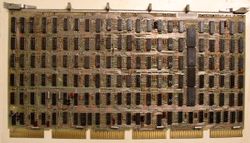KD11-D CPU
The KD11-D PDP-11 CPU of the PDP-11/04 was a micro-programmed processor (making heavy use of PROMs). It was contained on single hex card (the M7263), the first PDP-11 CPU to be built on a single card.
Like other early, low-cost PDP-11s, it did not support either memory management of any kind, or hardware floating point, EIS instructions, or the various instructions added to the PDP-11 instruction set (XOR, SOB, SXT and MARK).
There is a lack of clarity over the RTT instruction; the pdp11 04/05/10/35/40/45 processor handbook says it is not implemented, but the PDP-11 Architecture Handbook says "available in 11/04 but is different from other implementations"; the KD11-D Processor Manual (EK-KD11D-TM-PRE) says the "first instruction after RTT is guaranteed to be executed" - the same as the KD11-A CPU.
It plugs into a modified MUD backplane; either the DD11-C or DD11-D backplanes, or the special DD11-P backplane of the PDP-11/34.
KY11-L support
It supported the KY11-LA Operator's Console and the KY11-LB Programmer's Console, including the latter's maintenance functionality which allowed the CPU's microcode to be single-stepped. The KD11-D uses the same KY11-L to CPU interface as the other machines that use them.
The microcode diagnostic interface to the KY11-LB is carried over a 10-wire flat cable connected to i) the J2 Berg connector header on the KY11-LB's M7859 module (the other 10-pin header on that card is unused with the -11/04), and ii) to a set of bare vertical pins in the upper left-hand corner of the M7263 (see image above; between the 3rd and 4th chips in the top row). (The main functionality of the KY11-B is done over the UNIBUS, and a pair of backplane lines.)
External links
- KD11-D Processor Manual (PDP-11/04) (EK-KD11D-TM-PRE)
- PDP-11/04 engineering drawings - Contains KD11-D Field Maintenance Print Set (MP00020) on pp. 167-276 of the PDF(includes complete PROM dumps)
